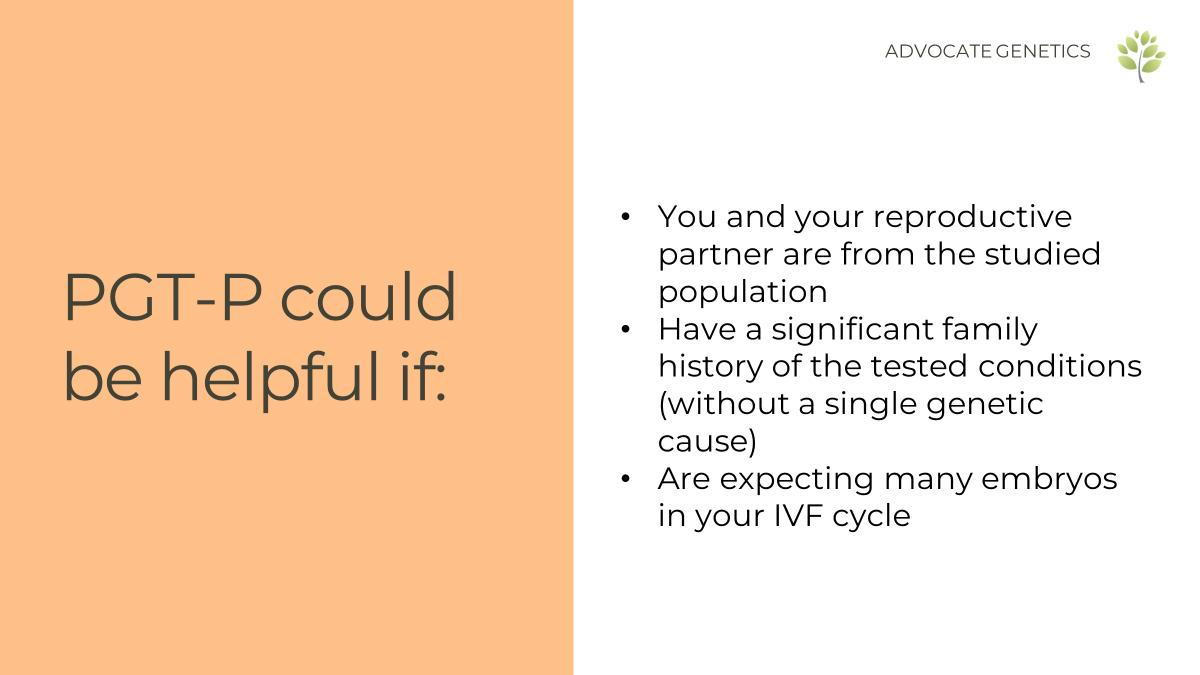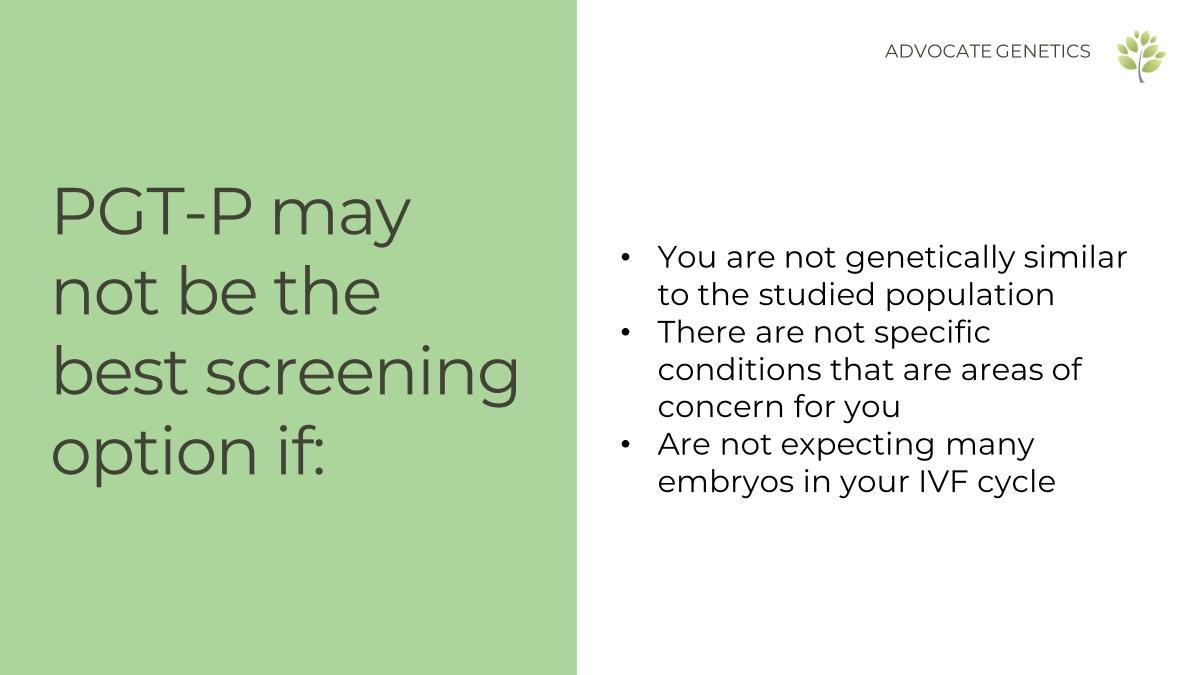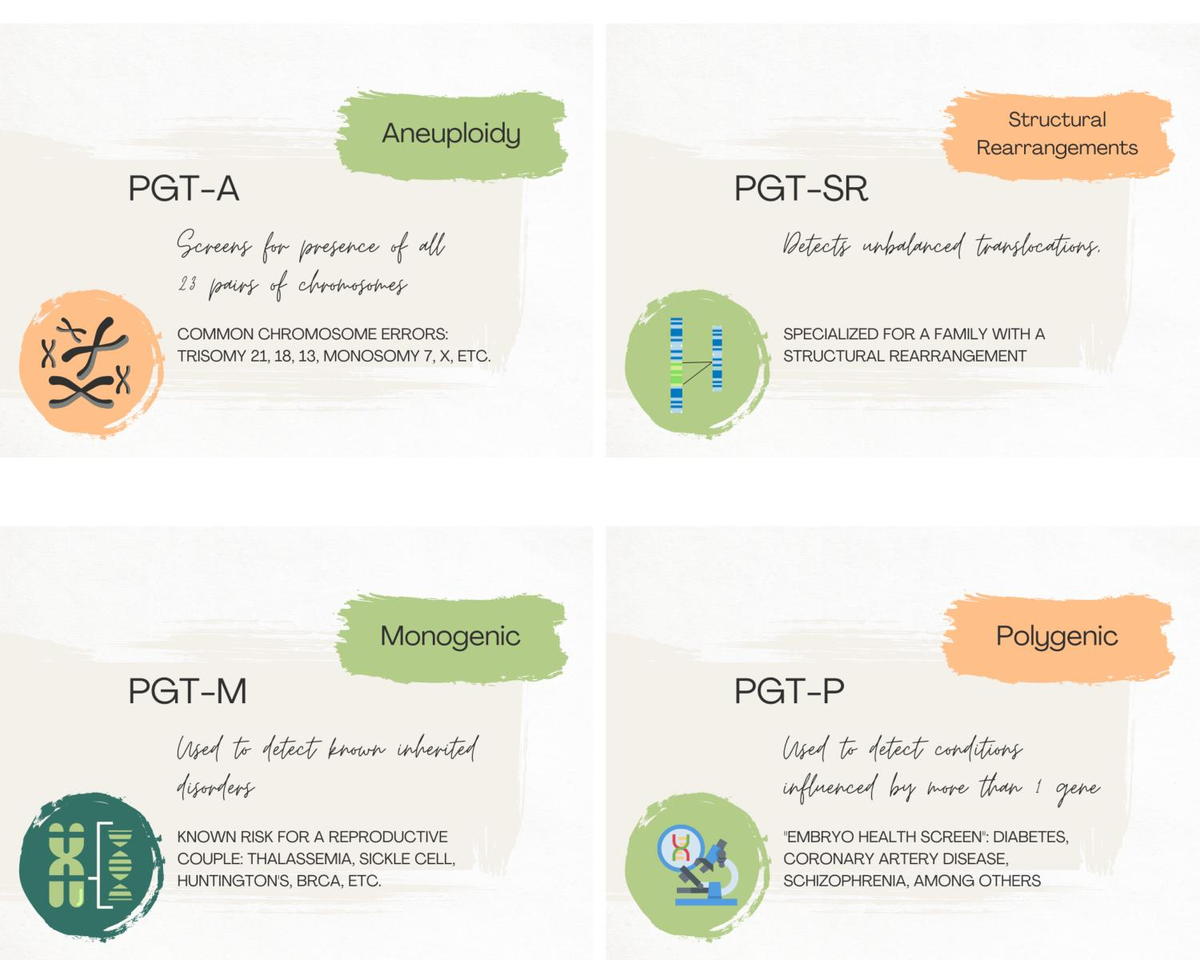Just like everything else touched by technology in the past few decades, the genetic testing options for embryos are evolving at a rapid pace. And to spice things up and keep people guessing, new acronyms have been invented along the way as well. Welcome to the alphabet soup of IVF. Would you care for some
PGT-A, PGT-M, PGT-SR, or PGT-P with your IVF cycle? If you find yourself scratching your head, we’re here to help.
PGT Types
As part of my internship, I reviewed and presented a
paper covering the newest iteration of this testing, PGT-P.
So, what exactly is PGT-P Testing? PGT-P testing is a quickly developing genetic screening test for embryos. It's kind of like the electric vehicle of the fertility world. Same basic architecture and it’s built to get you somewhere, but it uses a different fuel source. PGT-P stands for preimplantation genetic testing for polygenic risk. Polygenic risk scores (PRS) fuel the PGT-P engine. A PRS estimates an individual’s risk of developing an adult-onset, multifactorial condition by looking at the combination of specific genetic variants. But this is different than all other PGT technology that has come before it, because rather than focusing on a simple genetic issue (extra or missing genetic material, or single gene mutations causing genetic disease), it is looking at a bigger spectrum of disease, with more variation in the hereditary component.
A quick primer on PRS
● A PRS is calculated for each condition included in the analysis (currently limited to a handful of conditions, such as breast cancer and diabetes).
● Individuals with a high PRS have a higher incidence rate than the general population for that specific condition.
● If there is a family history of a specific illness, a PRS can help identify lower-risk embryos based on their combination of specific genetic variants.
● Inferences about PRS are most accurate when the tested embryo is similar to the studied population (i.e. Western European). (Sidebar: Yes, we are also shaking our heads at this particular play-out of
structural racism in biomedical research! My fellow intern, Yasaman Lorkalantari, explores the ethics of PGT-P
here. But stick with me so that you can understand the science itself first.
How are Embryos Scored?
Embryo Health Scoring (EHS) is a ranking system that combines multiple risk scores and factors to give an embryo an overall health score. This EHS can be used when deciding which embryos to prioritize for transfer. If we're approaching an IVF cycle using biomedical economics, essentially the EHS is the health score that an actuary would put on each embryo based on the specific variants the test measures, and factoring in the risk of the relevant diseases with the life-span impact of the condition. Conditions currently included on EHS scores are breast cancer, prostate cancer, testicular cancer, basal cell carcinoma, malignant melanoma, coronary artery disease, high cholesterol, hypertension, heart attack risk, type 1 diabetes, and type 2 diabetes. How and why were these diseases chosen, you ask? Convenience, mostly. As the research uncovers conditions for which good predictors exist, the list is expected to expand and evolve. It may be that future panel iterations will be able to aim for specific performance targets, and parents may be able to select a panel for longevity, quality of life, or cardiovascular health, similar to the way a parent might target their children’s college fund savings to a specific graduation year.
So the theory goes that if you were to elect to do PGT-P in a cycle, you could select to transfer the embryos that have the lowest risk of these conditions later in life. In reality though, it has been shown that embryos from the same IVF cycle can produce similar EHS scores due to their similar genetic makeup, as shown
here. This could present a dilemma for intended parents because it may not be very meaningful to distinguish embryos that have very similar EHS scores. If you were to buy in to the idea of PGT-P with the aim of reducing genetic risk for your children, it’s still possible that you could get your results back showing one embryo with a +1.3 EHS and another with a +1.2 EHS. When these scores cluster together so closely, we’d be talking about very similar disease risks, so choosing one for transfer over the other could be a challenge.
What's more is that we are very early in understanding the utility of PRS among adults, and we have no knowledge of how these PRS will pan out for embryos from another generation. Because these are conditions that are multifactorial in nature, the interactions of the individual's environment and their genetic variants will shape their actual disease risk. How many different variables are we talking about here? Kids today often have very different living environments than their parents did, with different norms for nutrition, physical activity, stress, trauma, and education. These variations in environment are all expected to
reduce the predictive power of a PRS that was derived from a previous generation.
Will PGT-P Benefit You?
Now that we have reviewed the basics of PGT-P and how it can be useful, how do you decide if it is the right testing for you? The biggest question to ask yourself is what are your goals of IVF? How do you feel about selecting embryos based on this information? Is there a significant health problem in the family that could be passed on? If there is a family history of one of the conditions included in the testing, PGT-P could potentially reduce the risk of the condition impacting your child. That said, you also want to consider other hereditary issues first! Taking breast cancer as an example, it’s important to know that a significant family history of breast or other cancers can be related to a much stronger genetic risk than PGT-P is designed to pick up. Speaking with a genetic counselor before an IVF cycle to understand your goals and concerns will enable you to explore the family history and determine if PGT-P fits your goals or if there are other actionable steps that might make sense.


It is important to remember that PGT-P is a screening test, meaning there is no guarantee that a specific embryo will or will not be affected by the condition. And of course, there is no “right” answer, just what you feel is in your family's best interest. Just like the early versions of the electric vehicle, PGT-P is not for everyone. My fellow intern, Yasaman, explores the relational and ethical impacts of this technology in the next
piece in our series.
Disclaimer: Please keep in mind that the information provided here is not meant to be a medical opinion about your specific case. The problems of every patient are unique and should be addressed by their physician or other health-care professionals in an individual conversation. You are welcome to bring up questions inspired by this blog post with your medical team. However, no one should use this blog as a source of medical care.



